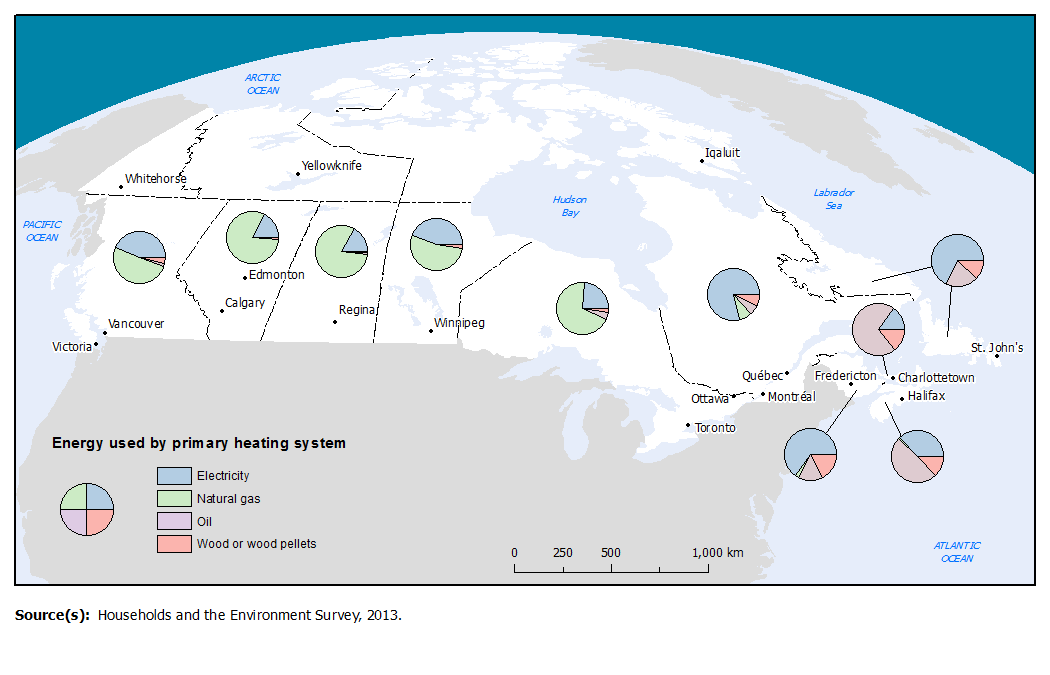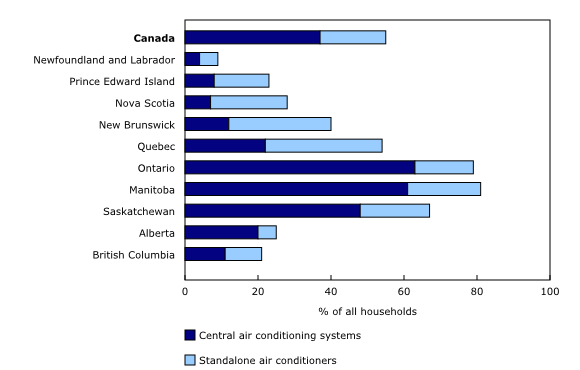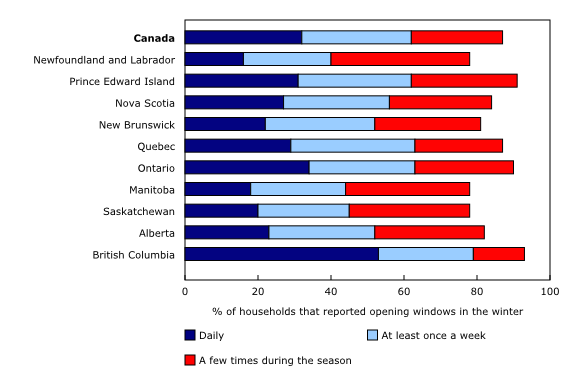Households and the Environment Survey, 2013
Archived Content
Information identified as archived is provided for reference, research or recordkeeping purposes. It is not subject to the Government of Canada Web Standards and has not been altered or updated since it was archived. Please "contact us" to request a format other than those available.
Released: 2015-03-10
How Canadians keep their homes warm in winter depends on which part of the country they call home. Data from the 2013 Households and the Environment Survey reveal that those from Ontario and in the West mostly opt for forced air furnaces burning natural gas. In Quebec and in the East, it is electric powered baseboard heaters and furnaces using heating oil that are found in an overwhelming majority of households.
Heating
Forced air furnaces were the most common type of heating system reported as a household's primary heating system (53%), followed by electric baseboard heaters (28%). Those figures were unchanged from 2011. Forced air furnaces were the dominant type of heating system in Ontario (73%) and the Prairie provinces (between 73% and 83%).
Households in Quebec (64%), Newfoundland and Labrador (59%) and New Brunswick (52%) were all more likely to have reported electric baseboard heaters. Forced air furnaces and boiler systems each accounted for about one-third of the primary heating system of households in Prince Edward Island.
The type of heating system used is strongly tied to the types of fuel available
In general, natural gas is available to most households from Ontario to British Columbia, with households in some parts of Quebec also having access. In Quebec and Atlantic Canada, heating oil replaces natural gas as the most common petroleum-based type of energy available.
Cooling
Unlike heating, cooling the home is optional for most Canadian households. In 2013, over half of Canadian households (55%) reported having an air conditioner, a slight increase from 2011. Two-thirds of the households that had an air conditioner had a central air conditioning system, while the other third had standalone systems, such as those mounted in windows or that could be moved from room to room.
Air conditioners were most commonly reported by households in Manitoba (80%), Ontario (78%), Saskatchewan (67%) and Quebec (54%), and less frequently in Prince Edward Island (23%), British Columbia (21%) and Newfoundland and Labrador (9%).
Households in provinces with higher rates of having an air conditioner were more likely to have had central air conditioning systems than standalone units.
The indoor environment
Canadians are quite conscious of their household air quality. More than 9 in 10 households rate indoor air quality as excellent (21%), very good (39%) or good (31%), while 7% classified their indoor air as being fair or poor.
There are a number of different ways a household can try to improve the air quality of its home. In 2013, 46% of households that had a forced air furnace reported using higher-quality filters in their furnace. Households in Manitoba were most likely to have reported this, with 6 in 10 households that had a furnace doing so. Conversely, households in Prince Edward Island (16%) were least likely to use higher-quality furnace filters. Over one-third (38%) of households that had a furnace reported using the furnace fan or a heat recovery ventilation system to increase air circulation.
Just over 2 out of 10 households (22%) reported using a humidifier to improve their indoor air quality, and 30% used a dehumidifier. Some households (10%) reported using both devices.
Beyond these methods, Canadians also simply open their windows, no matter the season, but not all provinces were as likely to use the fresh air option. For example, households in Newfoundland and Labrador were the least likely to open their windows in the winter time on a daily basis, with 16% reporting this, followed closely by households in Manitoba (18%). However, more than half of households in British Columbia (53%) opened their windows on a daily basis during the winter.
Indoor water conservation
Most Canadians get their water either from municipal systems or via surface sources or wells. In each case, reduced consumption can generate benefits, whether it be lower water bills or reduced energy costs for pumping the water from wells and surface sources, or reduced burden on the septic system leach field because of the reduced water loading.
Low-volume toilets
An average family of four people using a low-volume toilet will flush about 63% less water than an average family of four people using a traditional model.
In 2013, half of Canadian households reported having a low-volume toilet, up from 47% in 2011. Households in dwellings with a water meter were more likely to have a low-volume toilet than households in dwellings that did not have a water meter (61% compared with 42%).
Low-flow shower heads
Depending on the type of shower head used, showering may account for as much as 17% to 22% of total indoor water use.
In 2013, 60% of Canadian households had a low-flow shower head, down slightly from 63% in 2011. As with low-volume toilets, water-metered households were more likely to have had a low-flow shower head than households that did not have a water meter (65% compared with 58%).
Note to readers
The Households and the Environment Survey (HES) measures the behaviours of Canadian households with respect to the environment. It is a biennial survey, conducted under the umbrella of the Canadian Environmental Sustainability Indicators program, a broader initiative of Statistics Canada, Environment Canada and Health Canada.
First conducted in 1991, HES was subsequently conducted in 1994, 2006, 2007, 2009, 2011 and 2013. Some of the environmental variables from the first cycle continue to be measured, but many new topics have been introduced over the years.
The HES surveyed roughly 32,000 households.
The CD-ROM Households and the Environment Survey: Public Use Microdata File, 2013 (Catalogue number16M0001X), is now available from the Browse by key resource module of our website under Publications.
The fact sheet "Canadians and Nature: Birds, 2013" is also now available as part of the publication Enviro Fact Sheets (Catalogue number16-508-X) from the Browse by key resource module of our website under Publications.
Contact information
For more information, or to enquire about the concepts, methods or data quality of this release, contact us (toll-free 1-800-263-1136; 514-283-8300; infostats@statcan.gc.ca) or Media Relations (613-951-4636; statcan.mediahotline-ligneinfomedias.statcan@canada.ca).
- Date modified:




